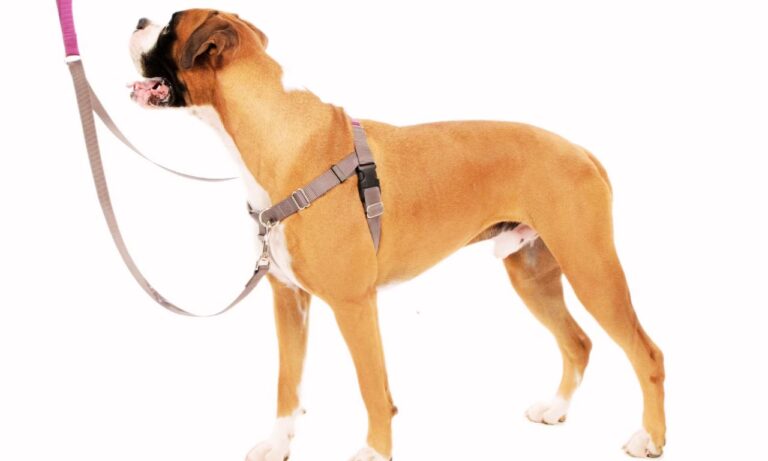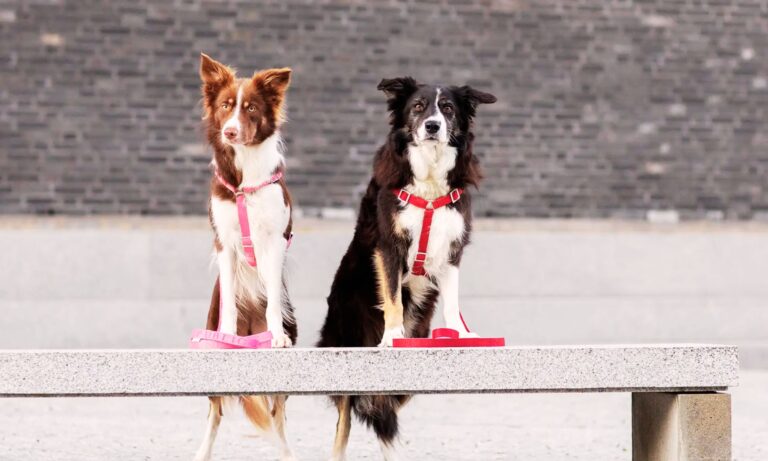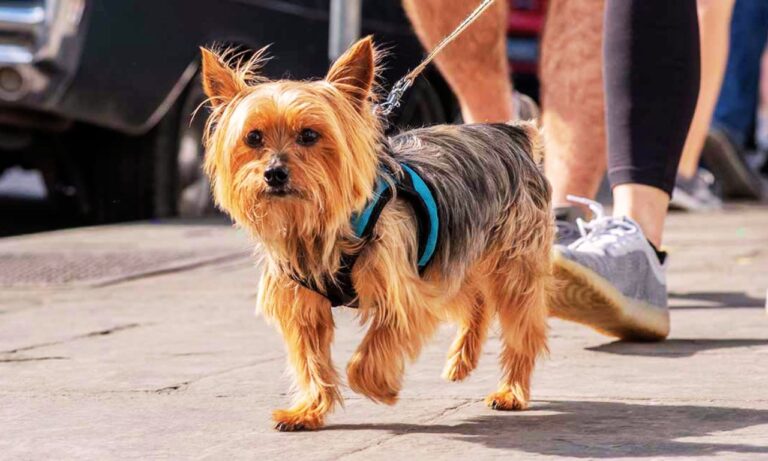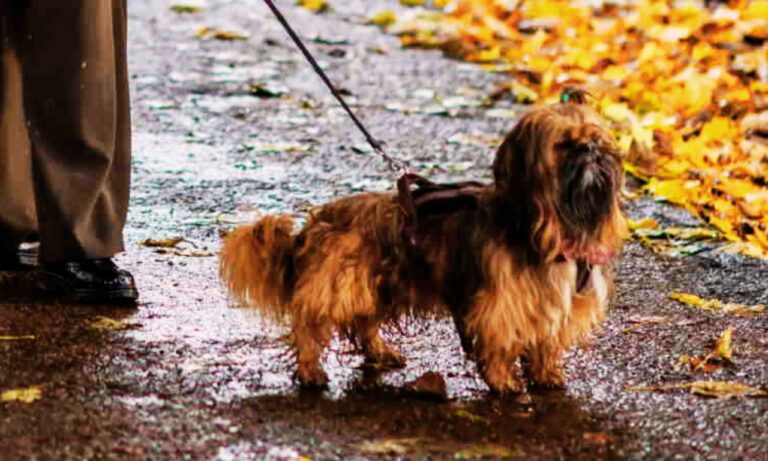| Summary: Rottweiler vs Cane Corso: The Rottweiler stands at 22-27 inches, weighing 80-135 lbs, with a muscular build and a strong guarding instinct. The Cane Corso, at 23-28 inches and 90-120 lbs, is an Italian mastiff bred for protection and work. Both breeds require firm leadership, early training, and proper socialization, but the Cane Corso has a more independent and dominant personality. |
Rottweiler vs Cane Corso are two of the most powerful guardian breeds, known for their strength, intelligence, and loyalty. While they share some physical similarities, dog temperaments, training needs, and suitability for different households vary significantly. If you are considering getting a Rottweiler or a Cane Corso, understanding their differences in size, behavior, training, and exercise requirements is essential.
For detailed guidance on ensuring the perfect collar fit for your St. Bernard, check out the Best Practices for St. Bernard Collar Adjustment to keep your dog comfortable and secure.
The Rottweiler, originally bred for herding and guarding livestock, has a rich history dating back to Roman times. The Cane Corso, an Italian mastiff, was bred for protection and working duties, making it highly alert and independent. Advanced GPS dog collars can help track their movement and exercise levels.
Blog Highlights
ToggleQuick Fix FAQ Table – Rottweiler vs Cane Corso
| Question | Answer |
| Which is bigger? | Cane Corso is taller (23-28 inches), but Rottweiler can be heavier (80-135 lbs). |
| Which is more protective? | Both are protective, but Cane Corso has stronger guarding instincts. |
| Which is better for families? | Rottweiler is more adaptable and affectionate, while Cane Corso needs experienced owners. |
| Who needs more exercise? | Cane Corso requires more exercise (90+ minutes daily), while Rottweiler needs around 60-90 minutes. |
| Which is easier to train? | Both are intelligent, but Cane Corso is more independent and requires a firm handler. |
Rottweiler vs Cane Corso: Breed Origins and History
Both the Rottweiler and Cane Corso are formidable working breeds with histories deeply rooted in protection, herding, and guarding. These dogs have been bred for centuries to serve their owners with loyalty, intelligence, and strength. However, their historical backgrounds differ in terms of their original functions, breeding purposes, and geographical origins.
Rottweiler: A Legacy from Ancient Rome to Modern Protection
The Rottweiler’s lineage can be traced back to the Roman Empire, where they were used primarily as drover dogs. The Romans required powerful, intelligent, and obedient dogs to accompany their legions, drive cattle, and guard valuables during their conquests. These early ancestors of the Rottweiler traveled across Europe with Roman soldiers, often protecting supply lines and ensuring that food sources remained intact for their armies.
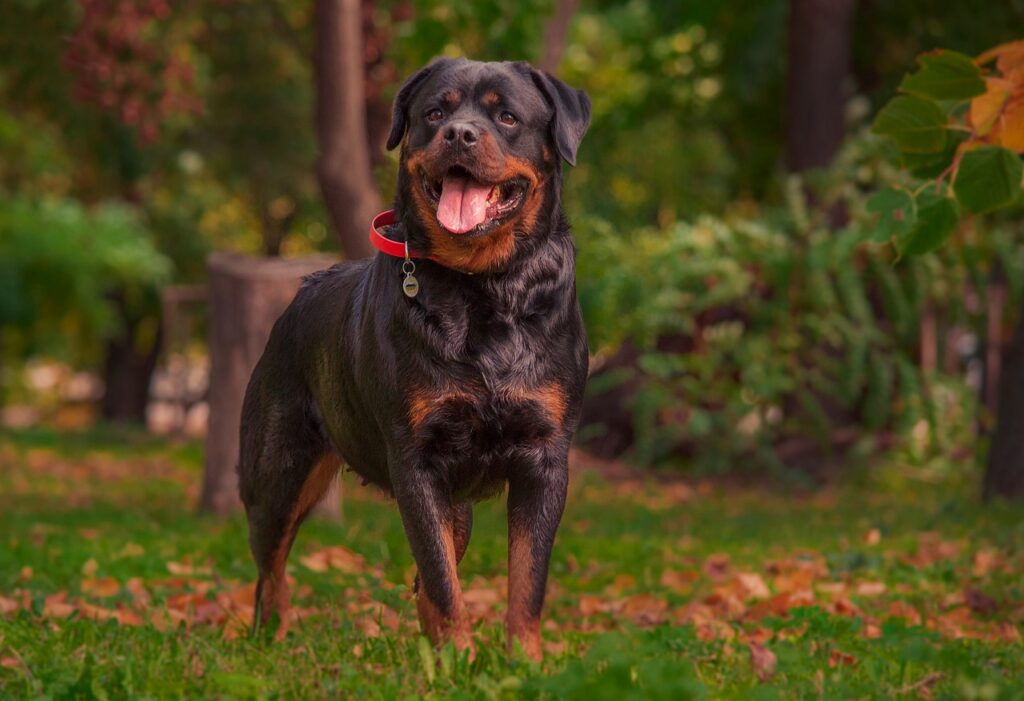
Ensure your Newfoundland’s comfort and security with expert tips on how to ensure a safe collar fit for Newfoundland.
As the Roman Empire expanded, these dogs were introduced to what is now Germany, particularly in the town of Rottweil. This town became an important hub for cattle trade, and the Roman drover dogs were bred selectively to enhance their herding and guarding abilities.
Over time, these dogs became known as “Rottweil Butcher’s Dogs” because they were commonly used by local butchers to drive cattle to market and protect money pouches tied around their necks. This protective nature became a defining characteristic of the breed.
During the late 19th century, as industrialization reduced the need for cattle-driving dogs, the Rottweiler nearly faced extinction. However, the breed found new purpose in police work, military service, and personal protection. Their intelligence, loyalty, and strong protective instincts made them valuable assets in law enforcement and security roles. Today, Rottweilers continue to serve in police and military operations, search-and-rescue missions, and as loyal family protectors.
Physical Development and Breed Refinement
Over generations, the Rottweiler was refined into the breed we recognize today. Selective breeding focused on enhancing their strength, endurance, and protective instincts. The breed standard solidified characteristics such as a muscular build, broad chest, and a confident yet composed demeanor. The modern Rottweiler retains the intelligence and determination of its ancestors but is also known for its deep bond with its family and protective nature.
Despite their reputation as fierce guardians, Rottweilers are affectionate, playful, and deeply loyal. However, their protective instincts mean they require structured training and socialization from a young age to ensure they develop into well-adjusted companions. Without proper guidance, they can become overly territorial or aggressive, which is why they thrive best under experienced ownership.
Discover the ideal fit by learning what size collar for Newfoundland dog to ensure your pet’s comfort and safety.
Cane Corso: The Ancient Roman Guardian Reborn
The Cane Corso shares a similarly rich history with the Rottweiler but differs in function and temperament. The breed descends from the ancient Roman Molossus, a large, powerful war dog used by the Roman military. These massive dogs were known for their brute strength, resilience, and fearlessness in battle. Unlike Rottweilers, which were bred primarily as drover dogs, the Cane Corso was designed to be a war and guardian breed.

After the decline of the Roman Empire, the Cane Corso transitioned from a war dog to a versatile working breed in Italy. They were commonly found on rural farms, where they excelled at guarding livestock, hunting large game such as wild boar, and protecting homes from intruders. Their intimidating presence, combined with their ability to make independent decisions, made them highly valued by farmers and landowners.
The name “Cane Corso” is derived from the Latin “cohors,” meaning “protector” or “guardian.” This highlights the breed’s primary role as a formidable guardian throughout history. Unlike Rottweilers, which adapted to various working roles, the Cane Corso maintained its guardian-focused lineage, making it one of the most naturally protective breeds.
Decline and Revival of the Breed
During the 20th century, the Cane Corso population declined significantly due to urbanization and the diminishing need for farm guard dogs. By the mid-1900s, the breed was on the verge of extinction. However, dedicated breeders in Italy began restoration efforts in the 1970s, selectively breeding remaining Corsos to preserve the breed’s traditional working capabilities.
Thanks to these efforts, the Cane Corso regained popularity and was officially recognized by the American Kennel Club (AKC) in 2010. Today, they are highly regarded as premier guardian dogs, known for their intelligence, confidence, and ability to assess threats.
For expert tips on how to fit a collar on a Belgian Shepherd, this guide offers simple steps to ensure your dog’s collar fits securely and comfortably.
Comparing the Origins and Historical Purposes
| Feature | Rottweiler | Cane Corso |
| Origin | Germany (Roman ancestry) | Italy (Roman ancestry) |
| Original Purpose | Herding, guarding, cattle-driving | War dog, guardian, hunting large game |
| Historical Function | Butcher’s dog, police/military work | Farm protector, hunting, estate guardian |
| Decline and Revival | Industrialization reduced demand, found new roles | Nearly extinct in the 20th century, revived in the 1970s |
| Modern Role | Family protection, police/military service, working dog | Guardian, estate protection, personal security |
Rottweiler vs Cane Corso: Key Differences in Historical Development
The Rottweiler and Cane Corso share a deep-rooted history that dates back to the Roman Empire. However, their paths diverged significantly based on their purpose, geographic development, and the efforts made to preserve their lineage. While both breeds are known for their intelligence, strength, and loyalty, their historical roles have shaped their temperaments, training needs, and suitability for different tasks.
1. Herding vs. Guarding: The Core Difference
Rottweiler: A Herding and Protection Breed
One of the most defining differences between Rottweilers and Cane Corsos is their original purpose. The Rottweiler’s history is closely tied to herding and cattle-driving. When the Roman Empire expanded across Europe, Roman soldiers brought large mastiff-type dogs to guard and move livestock. These dogs eventually became the ancestors of the modern Rottweiler.

As the Roman Empire declined, these dogs found a new role in the German town of Rottweil, where they were selectively bred to drive cattle to market, protect merchants’ money, and guard farms. This background made them highly trainable and deeply bonded to their human handlers. Unlike some independent working breeds, Rottweilers were bred to take direction from humans, making them one of the most obedient and versatile working dogs.
Even today, Rottweilers retain their strong herding and guarding instincts. They are protective of their families but not inherently aggressive, and their ability to assess threats makes them excellent police and service dogs.
Cane Corso: A Dedicated Guardian and Hunter
In contrast, the Cane Corso was never used for herding but was bred exclusively for guarding, hunting, and protection. Its lineage traces back to the Roman Molossus, a war dog used by Roman soldiers. After the fall of the empire, the Cane Corso transitioned from a battlefield companion to a farm guardian, protecting livestock, property, and families from predators and thieves.
Both breeds require early socialization and consistent training to ensure they grow into well-balanced, obedient companions. Dog training equipment is essential for building discipline and confidence.
Unlike Rottweilers, which worked closely with humans in herding and obedience-based tasks, Cane Corsos were bred to be more independent and self-reliant. They needed to make quick decisions when faced with threats, whether defending a homestead or hunting wild boar. This independent streak means that, while intelligent, they can be more challenging to train and require a firm, experienced owner.
Another key difference is their territorial nature. Rottweilers, though protective, are more accepting of strangers when properly socialized. Cane Corsos, on the other hand, are naturally wary of outsiders and tend to be more aloof, making them excellent guard dogs but requiring early socialization to prevent excessive aggression.
👉 Key Takeaway: The Rottweiler was bred for herding and guarding livestock, making it more obedient and trainable. The Cane Corso, bred for guarding and hunting, is more independent and naturally territorial.
For detailed guidance on selecting the correct collar size for a Belgian Shepherd, this article provides essential tips to ensure your dog’s comfort and safety.
2. Roman Military Influence: A Shared Ancestry with Different Roles
Rottweilers as Drover Dogs in the Roman Empire
Both breeds share an ancestry dating back to ancient Rome, but their roles within the Roman Empire were different. The Rottweiler’s ancestors were drover dogs, responsible for moving cattle alongside Roman soldiers. These dogs played a crucial role in feeding the military by ensuring livestock could travel long distances.
Since drover dogs had to keep cattle in check while being exposed to constant movement and changing environments, they needed to be both protective and highly trainable. This intelligence and adaptability allowed Rottweilers to excel not just as herding dogs but also in modern police and service work.
Cane Corso as a Roman War Dog
The Cane Corso’s ancestors, on the other hand, were war dogs. Unlike the Rottweiler’s ancestors, which managed livestock, the Cane Corso’s predecessors were bred for combat. They accompanied Roman soldiers into battle, serving as frontline attack dogs and protecting encampments. These dogs were trained to charge enemies, bite and hold opponents, and even carry flaming barrels into enemy lines.
This history of warfare gave the Cane Corso its unmatched courage, territorial instincts, and imposing presence. Even after the Roman military declined, the breed’s protective instincts remained intact. Cane Corsos continued to be used for hunting large game, guarding homesteads, and even defending against bandits in rural Italy.
👉 Key Takeaway: Rottweilers originated from Roman drover dogs that managed livestock, making them highly trainable and people-oriented. Cane Corsos descended from war dogs, giving them a stronger guarding instinct and more independent nature.
3. Breed Preservation Efforts: Survival Through Changing Times
The Rottweiler’s Transition from Herding to Police Work
The Rottweiler’s role in society shifted significantly as industrialization reduced the need for cattle-driving dogs. By the late 19th and early 20th centuries, the breed faced a decline, as herding was no longer a primary occupation. However, the breed’s intelligence, loyalty, and protective instincts allowed it to transition into new roles.
Rottweilers tend to be more affectionate and playful, while Cane Corsos are highly protective and require firm leadership. Electronic dog collars assist in reinforcing training and behavior correction.
Rather than fading into obscurity, Rottweilers found work in police forces, military operations, and search-and-rescue missions. Their ability to follow commands and remain calm under pressure made them one of the top choices for law enforcement. By the mid-20th century, Rottweilers were once again thriving, not as herding dogs but as trusted working companions in security and protection.
Today, Rottweilers are among the most popular working breeds worldwide. They excel in obedience competitions, search-and-rescue missions, and even therapy work, proving their versatility and adaptability.
Discover the perfect collar size for an Anatolian Shepherd Dog to ensure comfort and security for your furry friend.
The Cane Corso’s Near Extinction and Revival
While the Rottweiler successfully transitioned into police work, the Cane Corso was not as fortunate. By the mid-20th century, as Italy modernized, the need for large farm guardians declined. The breed’s population dwindled to the point of near extinction, surviving only in remote rural areas.
It wasn’t until the 1970s and 1980s that breed enthusiasts made efforts to revive the Cane Corso. Selective breeding programs helped re-establish the breed, and by the 1990s, the Cane Corso was officially recognized by major kennel clubs. Despite this revival, the breed remains rarer than the Rottweiler and is still primarily used as a guard dog rather than a police or service dog.
Cane Corsos are taller and leaner, whereas Rottweilers have a stockier build with a broad chest and muscular frame. Pet tech products like smart feeding systems can help maintain their ideal weight.
👉 Key Takeaway: The Rottweiler successfully adapted to new roles like police and service work, securing its place as a widely recognized breed. The Cane Corso nearly went extinct but was revived through dedicated breeding efforts, remaining a specialized guardian breed.
Cane Corso vs Rottweiler: Size and Physical Appearance
| Feature | Rottweiler | Cane Corso |
| Height (Males) | 24 – 27 inches | 24 – 28 inches |
| Height (Females) | 22 – 25 inches | 23 – 26 inches |
| Weight (Males) | 95 – 135 lbs | 90 – 120 lbs |
| Weight (Females) | 80 – 100 lbs | 80 – 110 lbs |
| Body Type | Muscular, compact | Lean, powerful, athletic |
| Head Shape | Broad skull, strong jaw | Large, square, pronounced jaw |
The Rottweiler has a stocky, muscular build with a broad chest and a distinct black-and-tan coat. Their short, dense fur requires minimal grooming but sheds year-round.
Cane Corsos, on the other hand, are taller and leaner, with a more athletic build. Their coat is short but denser than a Rottweiler’s, requiring occasional brushing. Cane Corsos also have cropped ears in many countries, which enhances their alert expression.
👉 Key Difference: The Cane Corso is taller and more athletic, while the Rottweiler is stockier and often heavier.
The Rottweiler and Cane Corso are both powerful guardian breeds, but Rottweilers are more social, while Cane Corsos are more reserved. GPS dog collars help track their movements during training and exercise.
Cane Corso vs Rottweiler: Temperament and Behavior
Rottweiler Temperament
Rottweilers are known for their loyalty, intelligence, and affectionate nature. Despite their reputation as fierce guard dogs, they form strong bonds with their families and are incredibly gentle with children when raised properly. They are highly trainable and eager to please, making them excellent working dogs.

However, Rottweilers can be wary of strangers and require early socialization to prevent overprotectiveness. They thrive in structured environments and need firm, consistent training. Without proper guidance, they can develop territorial or aggressive tendencies.
Cane Corso Temperament
Cane Corsos are highly intelligent, confident, and naturally protective. Unlike Rottweilers, which can be social and playful, Cane Corsos are more independent and reserved. They are extremely loyal to their families but remain cautious around strangers.
Due to their strong prey drive and dominant personality, Cane Corsos need experienced handlers who can provide structure and leadership. If not properly trained, they can become overly dominant or aggressive.
👉 Key Difference: Rottweilers are more affectionate and social, while Cane Corsos are more reserved and independent.
Learn more about the unique double-layered coat of an Anatolian Shepherd and how to care for it effectively.
Cane Corso vs Rottweiler: Training and Obedience
Rottweilers are highly intelligent and eager to learn. They respond well to positive reinforcement and structured training methods. Their natural work ethic makes them excellent candidates for obedience training, agility work, and protection sports.
Cane Corsos, while equally intelligent, are more independent and require a firm, experienced handler. They do not respond well to inconsistent training or harsh discipline. Establishing leadership early on is crucial to prevent behavioral issues.
👉 Key Difference: Rottweilers are easier to train due to their eagerness to please, while Cane Corsos require an assertive and experienced owner.
Cane Corso vs Rottweiler: Exercise and Energy Levels
Rottweilers have moderate to high energy levels and require around 60-90 minutes of daily exercise. They enjoy running, hiking, and playing fetch, making them excellent companions for active families.

Cane Corsos, being true working dogs, require at least 90-120 minutes of physical and mental stimulation daily. They excel in protection training, agility work, and advanced obedience training. Without enough exercise, they can become restless or destructive.
👉 Key Difference: Cane Corsos require more exercise and mental stimulation compared to Rottweilers.
Cane Corso vs Rottweiler: Health and Lifespan
| Health Concern | Rottweiler | Cane Corso |
| Hip Dysplasia | Common | Common |
| Elbow Dysplasia | Common | Common |
| Bloat | Risk | Risk |
| Heart Issues | Risk | Risk |
| Lifespan | 9 – 10 years | 9 – 12 years |
Both breeds are prone to hip and elbow dysplasia, as well as bloat, a life-threatening condition. Regular veterinary check-ups and a proper diet can help maintain their health.
Which Breed is Right for You?
Understanding the historical backgrounds of the Rottweiler and Cane Corso provides valuable insight into their modern temperaments and needs. If you are looking for a highly trainable and affectionate guard dog that enjoys structured training, the Rottweiler may be the better choice. However, if you need a natural guardian with an independent personality and strong territorial instincts, the Cane Corso might be the perfect fit.
Both breeds require experienced handling, consistent training, and early socialization. Without proper guidance, their protective instincts can become problematic. Potential owners should carefully consider their lifestyle, training ability, and experience before committing to either breed.
For insights on whether Pomeranians should wear a collar, including considerations for safety and alternatives, check out this informative article.
Wrapping Up
Both the Rottweiler vs Cane Corso are powerful, intelligent breeds, but they cater to different lifestyles. The Rottweiler is affectionate, trainable, and protective, making it a great family guardian. The Cane Corso, while equally loyal, is more independent and requires an experienced owner.
If you want a social yet protective family companion, the Rottweiler is an excellent choice. However, if you need a serious guardian with strong work ethics, the Cane Corso is the better option.For a comprehensive guide on what kind of harness is best for a Pomeranian, including comfort and safety tips, check out this article.


